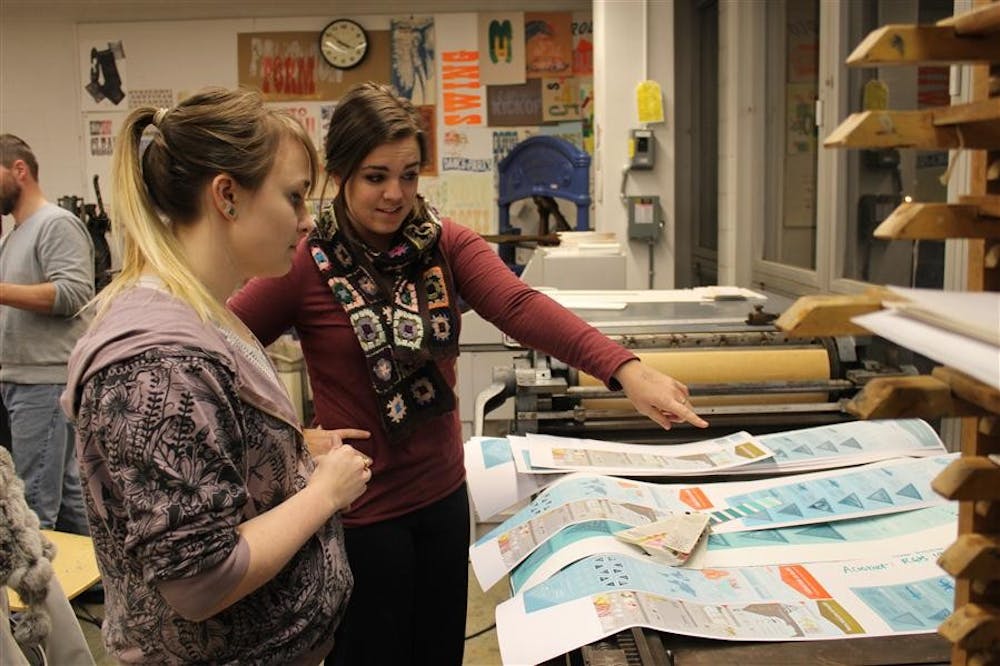Squeaky elevator doors opened to reveal the second floor of the School of Fine Arts. Handcrafted metal jewelry was displayed inside glass cases that framed the hallway. Campaign posters and invites to various media shows were splashed intermittently across the tan walls. In one of the very last studios, the five senior graphic design students worked meticulously to add final touches to their thesis projects. ¶ Each of the pieces are a semester’s worth of research and work. The thesis project has loomed in the back of the students’ minds since their acceptance into the program. This is the first time all five designers will display their work in one place.
¶ “We’ve all been going through this together,” said senior designer Cristina Vanko, who also works for the Indiana Daily Student. “We’re going to see the end product together.” ¶
Their work will be on display Dec. 6 to 10 with a reception from 6 to 8 p.m. Friday in the Grunwald Gallery of Art.
¶ Senior Ross Frazier’s project “Buried” explores eight burial rituals of four different cultures. The eight rituals are broken down by one of the four elements of nature: wind, air, fire and earth. Frazier created four fictional personas to embody the practices, displayed on 6-foot-high panels.
¶ “It’s a little taboo,” Frazier said. “And that’s kind of one of the things I was aiming for, to kind of deal with those subjects and not in an emotional ‘let’s cry about it’ kind of way.”
¶ Although their major falls under the Fine Arts umbrella, the five designers stressed the power of graphic design to convey information versus emotions. The Professional Association for Design defines graphic design as a creative process that combines art and technology to communicate ideas.
¶ “I’m a designer because I’m not necessarily a fine arts-oriented person,” senior artist Karen Radewald said. “I am really more interested in the communicative power of design. So, that’s something I really wanted to emphasize with this.”
¶ Radewald created three 9-foot panels that she said explore the standstill between oceanic discovery and oceanic destruction. The size is meant to submerse the audience in an aquarium-like setting. ¶
“Everyone’s projects are on a scale that I don’t really think has been explored before in our program,” Radewald said. “All of our projects are huge in size compared to size in projects of past semesters, so it’s kind of exciting to see them allso big in the gallery.”
Each of the designers were encouraged to choose a topic they felt strongly about because the project’s work lasted the whole semester.
Not only were they presenting the findings textually, but also visually.
Senior designer Allison Tylek, who also works for the IDS, combined her graphic design major and psychology minor in a piece titled “The Creative Complex.”
She created a total of 10 panels with information and graphics both handmade and computer-generated.
The project compiles research about the effects sleep and stress have on creative thinking and how creativity evolves throughout a lifespan, among other brain processes and their relationship to creativity.
“Going into this, I started out saying I just wanted to do a piece trying to define what creativity was,” Tylek said. “During my research phase, I came into a lot of problems because there hasn’t been a lot of research into this topic. It’s really hard to define what creativity is because it changes from perspective to perspective.”
For Vanko, creativity is returning to the roots of instruction, specifically with handwriting.
This past summer, Vanko’s “Sans Cursive” campaign for cursive instruction was born.
Forty-five states have removed mandatory cursive instruction from their
curriculum.
When waiting for a bus during her internship, Vanko met a man who was illiterate. She said she began to wonder if our history will soon be indecipherable to children in the future, much like the fate of hieroglyphics.
The severity of our nation’s adaptation to technology and the trend of teaching keyboarding in schools came as a sad realization, Vanko said.
“My little brother picked up a Gameboy and learned how to read playing Pokemon because he had to ask my dad, ‘What’s this say? How do I get to the next level?’” Vanko said.
Her four black, red and white chalkboards highlight the benefits of cursive instruction she sees: to uncover history, express yourself, stimulate the brain and refine motor skills.
Vanko also created a book that includes visuals of the chalkboards in addition to the history of cursive writing, the legislation removing cursive instruction and a handwriting test.
At the exhibit’s end, audience members can send a postcard asking the National Governor’s Association to encourage teaching cursive handwriting.
“It’s not only a chalkboard,” Vanko said. “It’s a different way to communicate.”
Senior artist Meghan Frost said she always knew she wanted to create a project that would incorporate both her graphic design and business majors.
The result? A mock annual report format broken down into the four Ps of marketing: price, promotion, product and place.
“I was applying for these jobs, and I really wasn’t excited about the interviews or the companies or the position, and I found that it was really coming across in the interview,” Frost said. “I wanted to come up with a way to do this whole job search on your own and be excited about it.”
Frost wanted her piece to work on both a large and a small scale, so she printed four posters of some of the graphics in the annual report. For Frost, conveying her concepts visually as opposed to textually was the hardest part.
“A lot of design isn’t meant to be not necessarily showcased,” Frost said. “The best design you don’t even realize.”
Big Impact: 5 graphic design majors to present their final show

Get stories like this in your inbox
Subscribe





